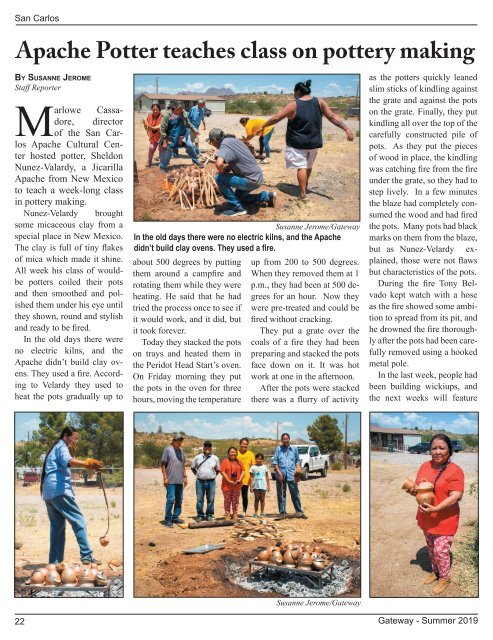You also want an ePaper? Increase the reach of your titles
YUMPU automatically turns print PDFs into web optimized ePapers that Google loves.
San Carlos<br />
Apache Potter teaches class on pottery making<br />
By Susanne Jerome<br />
Staff Reporter<br />
Marlowe Cassadore,<br />
director<br />
of the San Carlos<br />
Apache Cultural Center<br />
hosted potter, Sheldon<br />
Nunez-Valardy, a Jicarilla<br />
Apache from New Mexico<br />
to teach a week-long class<br />
in pottery making.<br />
Nunez-Velardy brought<br />
some micaceous clay from a<br />
special place in New Mexico.<br />
<strong>The</strong> clay is full of tiny flakes<br />
of mica which made it shine.<br />
All week his class of wouldbe<br />
potters coiled their pots<br />
and then smoothed and polished<br />
them under his eye until<br />
they shown, round and stylish<br />
and ready to be fired.<br />
In the old days there were<br />
no electric kilns, and the<br />
Apache didn’t build clay ovens.<br />
<strong>The</strong>y used a fire. According<br />
to Velardy they used to<br />
heat the pots gradually up to<br />
Susanne Jerome/<strong>Gateway</strong><br />
In the old days there were no electric kilns, and the Apache<br />
didn’t build clay ovens. <strong>The</strong>y used a fire.<br />
about 500 degrees by putting<br />
them around a campfire and<br />
rotating them while they were<br />
heating. He said that he had<br />
tried the process once to see if<br />
it would work, and it did, but<br />
it took forever.<br />
<strong>To</strong>day they stacked the pots<br />
on trays and heated them in<br />
the Peridot Head Start’s oven.<br />
On Friday morning they put<br />
the pots in the oven for three<br />
hours, moving the temperature<br />
up from 200 to 500 degrees.<br />
When they removed them at 1<br />
p.m., they had been at 500 degrees<br />
for an hour. Now they<br />
were pre-treated and could be<br />
fired without cracking.<br />
<strong>The</strong>y put a grate over the<br />
coals of a fire they had been<br />
preparing and stacked the pots<br />
face down on it. It was hot<br />
work at one in the afternoon.<br />
After the pots were stacked<br />
there was a flurry of activity<br />
as the potters quickly leaned<br />
slim sticks of kindling against<br />
the grate and against the pots<br />
on the grate. Finally, they put<br />
kindling all over the top of the<br />
carefully constructed pile of<br />
pots. As they put the pieces<br />
of wood in place, the kindling<br />
was catching fire from the fire<br />
under the grate, so they had to<br />
step lively. In a few minutes<br />
the blaze had completely consumed<br />
the wood and had fired<br />
the pots. Many pots had black<br />
marks on them from the blaze,<br />
but as Nunez-Velardy explained,<br />
those were not flaws<br />
but characteristics of the pots.<br />
During the fire <strong>To</strong>ny Belvado<br />
kept watch with a hose<br />
as the fire showed some ambition<br />
to spread from its pit, and<br />
he drowned the fire thoroughly<br />
after the pots had been carefully<br />
removed using a hooked<br />
metal pole.<br />
In the last week, people had<br />
been building wickiups, and<br />
the next weeks will feature<br />
22<br />
Susanne Jerome/<strong>Gateway</strong><br />
<strong>Gateway</strong> - Summer 2019




